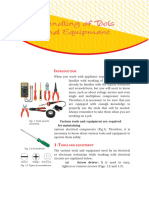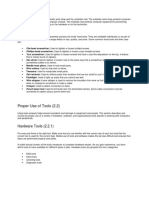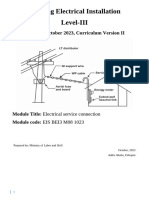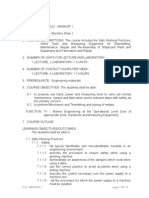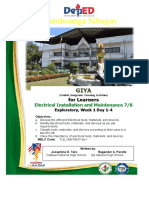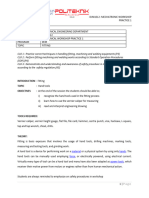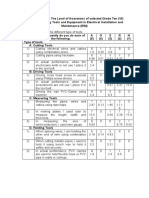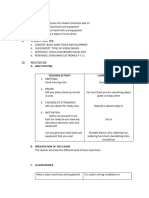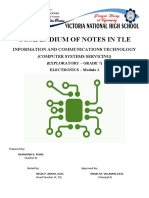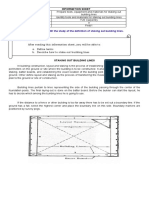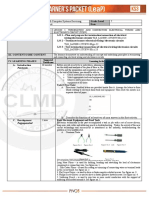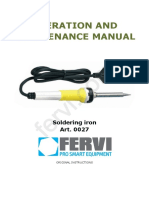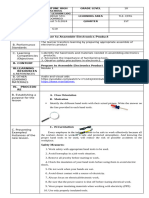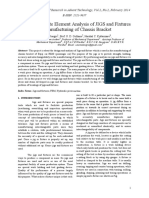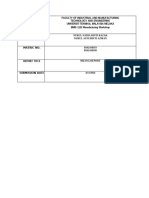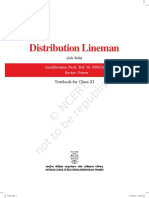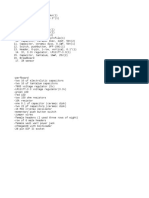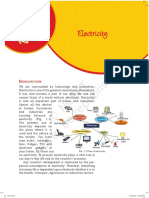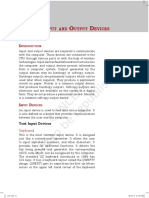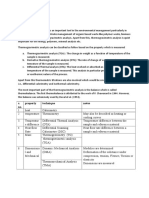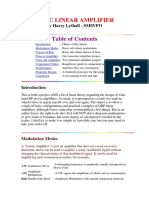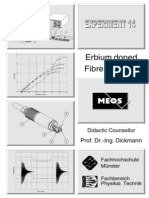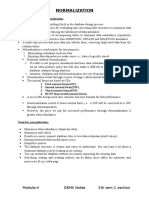Handling of Tools and Equipment: Ntroduction
Handling of Tools and Equipment: Ntroduction
Uploaded by
anshuman singhCopyright:
Available Formats
Handling of Tools and Equipment: Ntroduction
Handling of Tools and Equipment: Ntroduction
Uploaded by
anshuman singhOriginal Title
Copyright
Available Formats
Share this document
Did you find this document useful?
Is this content inappropriate?
Copyright:
Available Formats
Handling of Tools and Equipment: Ntroduction
Handling of Tools and Equipment: Ntroduction
Uploaded by
anshuman singhCopyright:
Available Formats
2 Handling of Tools
and Equipment
INTRODUCTION
When you work with appliance repair, you need to be
familiar with working of the tools. You may
already be familiar with the typical wrenches
and screwdrivers, but you will need to know
more, such as about voltage meters and even
single and multiphase compressor testers.
Therefore, it is necessary to be sure that
you are equipped with enough knowledge to
properly use the tools that will be needed.
Always remember to take them when you are
working on a job.
Fig. 2.1 Tools used in electricity Various tools and equipment are required
for maintaining as well as erection of
various electrical components (Fig. 2.1). Therefore, it is
necessary to know about various tools and equipment
to operate them safely.
SESSION 1: TOOLS AND EQUIPMENT
Fig. 2.2 Screwdriver
The various tools and equipment used by an electrical
or electronic technician while working with electrical
circuits are explained below:
Slotted Phillips Robertson (a) Screw driver: It is used to turn, tighten or remove
Fig. 2.3 Types of screwdrivers screws (Figs. 2.2 and 2.3).
Unit-2 Handling of Tools and Equipments.indd 32 07-06-2019 12:36:17
(b) Ratchet: It is used to allow rotary motion in only one
direction and preventing the motion in opposite direction.
It is used to tighten nuts of various sizes (Fig. 2.4).
(c) Spanner: It is used to provide grip to apply torque
for turning objects such as nut or a bolt. A spanner
is available with variable diameter to tighten nuts and
Fig. 2.8 Tester
bolts of various sizes (Fig. 2.5).
(d) Wrench: It is a hand tool used for tightening and
loosening of the nuts and bolts (Fig. 2.6). These tools
hold slippery or small nuts and bolts for loosening or
tightening it.
(e) Wire cutter and Plier: A wire cutter is used for
Fig. 2.9 Hammer
striping and cutting wires whereas a plier is used to
hold objects like nuts and bolts firmly also used for
cutting metal wires (Fig. 2.7).
(f) Tester: It is used to verify the presence of electric
voltage in electrical equipment (Fig. 2.8).
(g) Hammer: It is used to fix nails in walls and
wood, fit parts, or forge metal and breaking different
materials (Fig. 2.9).
(h) Ladder: It is used to climb upwards to reach
higher places (6 to 7 feet) in tall units of a control Fig. 2.10 Ladder
panel (Fig. 2.10).
(i) Utility Knife: It is used to cut various objects, such
as wires, cords, tapes and so on (Fig. 2.11).
(j) Soldering or Desoldering Iron: It is used to embed/
remove the components on/from the panel (Fig. 2.12).
(k) Soldering or Desoldering Station: It is used to Fig. 2.11 Utility knife
hold the hot iron when it is not in use and adjust the
temperature of the tip (Fig. 2.13).
Fig. 2.6 Wrench Fig. 2.12 Soldering or
desoldering iron
Fig. 2.4 Ratchets
Fig. 2.13 Soldering or
Fig. 2.5 Spanner Fig. 2.7 Wire cutter and plier desoldering station
HANDLING OF TOOLS AND EQUIPMENT
33
Unit-2 Handling of Tools and Equipments.indd 33 07-06-2019 12:36:20
(l) Crimping Tool: It is used to cut various objects such
as wires, cords, tapes and so on. It is also used to join
wires with metal or plastic objects (Fig. 2.14).
(m) Voltmeter: It is used to measure potential difference
between two points in the electric circuit (Fig. 2.15).
Fig. 2.14 Crimping tool
(n) Ammeter: It is used to measure current flow in
a circuit (Fig. 2.16).
(o) Watt meter: It is used to measure electrical power of
any given circuit (in watts) (Fig. 2.17).
(p) Megohmmeter or Megger: It is used to measure
leakage in wires and earth resistance (Fig. 2.18).
Fig. 2.15 Voltmeter (q) Multimeter: It is used to measure various electrical
quantities like resistance, voltage, current, etc (Fig. 2.19).
Fig. 2.16 Ammeter Fig. 2.17 Watt meter Fig. 2.18 Megger Fig. 2.19 Multimeter
Check Your Progress
A. Fill in the blanks
1. _________________ is used to allow rotary motion in only
one direction. It is used to tighten nuts and bolts.
2. Crimping tool is used for joining wires with ____________
or ___________ objects.
3. In an electric tester __________bulb is used.
B. Identify whether the following statements are True or False
1. Always examine the tool for damages before use.
2. It is OK to wear loose clothing, dangling objects and
jewellery using hand tool.
3. Keep cords and hoses away from heat, oil and
sharp edges.
4. Before connecting any electrical equipment to a power
source, make sure the power is on.
C. Short answer questions
1. Can a wire cutter be used in place of a plier? Explain in
brief.
2. How do tools and equipment help ease an electrical
technician’s work?
DISTRIBUTION LINEMAN — CLASS XI
34
Unit-2 Handling of Tools and Equipments.indd 34 07-06-2019 12:36:21
SESSION 2: TOOLS AND EQUIPMENT USED FOR
CABLE LAYING
Preparations of Cables and Equipment for
Cable Laying Activities
Tools and equipment are used for various electrical
activities. We should take care while handling the
electrical wire laying. While laying the cables necessary
precautions and health and safety practices for power
related work should be observed as per standard rules.
Important tools and equipment used for laying electrical
wire (laying works) are given here.
Fig. 2.20 Cable drum
Tools and Equipment used in Cable Laying with cable
Activities
Many tools are used for cable laying. These include cable
pulling winch, cable guiding device and cable pulling
grip, etc.
Cable Drums
Cable gets twisted during laying process. Drums are
used to check or avoid twisting of cables. Cable drums Fig. 2.21 Cable drum
without cable
(Figs 2.20 and 2.21) help the technicians with the laying
of cables. Similarly angle rollers are also used for laying
the cable (Fig. 2.22).
Pulling Methods and Calculations
Proper methods should be used while laying the cable
in the field. Suitable equipment and tools must be used
in this process. The cable drum should be mounted
on jacks and the cable should be rolled off the drum Fig. 2.22 Angle rollers
gently avoiding kinks and twists. The free end in the
Cable-Reel
case of heavy cables may be pulled with the help of Mounted
on Jacks
a winch. Laying cable in an open trench presents no
serious difficulty. The cable is first placed on rollers
Cable
laid in the trench or on the ground above, which is
then transferred to the bed of the trench. When laying
cables in pipes and ducts, care should be exercised so Incorrect Correct
as not to damage them during installation. The correct Method Method
method of laying of cables for installation in a duct is Fig. 2.23 Pulling Methods
shown in Fig. 2.23.
HANDLING OF TOOLS AND EQUIPMENT
35
Unit-2 Handling of Tools and Equipments.indd 35 07-06-2019 12:36:23
Testing of Underground Cables
After laying cables underground or above the ground,
proper testing is done to check the faults caused,
if any, due to the laying. The cables are tested for
short circuiting faults, discontinuity faults and earth
fault. Murray and Varley loop tests are done to check
these faults.
Tools Used for Erection and Maintenance
A lineman who is doing erection and maintenance work,
cannot do his job without proper hand tools, which
he carries around on a daily basis. Unlike tools used
by any other worker, a lineman’s tools require proper
insulation, because these tools are used with electrical
installations. The handles of these tools are coated with
rubber to prevent the worker from getting electrocuted
Fig. 2.24 Tools for erection
and maintenance
(Fig. 2.24).
Tools are important to carry out a job. The entire
job being carried out by a technician is with the help of
tools. The following tools are commonly used for working
in a distribution system:
(a) Combination Pliers
It is used for cutting, removing insulation, jointing
and twisting the electric wires and cables even on
live-line. A lineman’s pliers have special design,
which multiplies force through leverage. These pliers
usually have grips for better handling than bare metal
handles. The grips also have insulation for protection
against electric shock when working with live circuits.
Fig. 2.25 Combination plier A lineman’s pliers are typically machined from forged
steel. The two handles are precisely joined with a
heavy-duty rivet that maintains the pliers’ accuracy
even after repeated use under extreme force on heavy-
gauge wire (Fig. 2.25).
(b) Adjustable Wrench
It is used to open and close nuts and bolts in case
of proper size spanner not being available. Common
sizes are 8” (Inch) to 12” (Inch). Adjustable wrenches
are designed to provide a wide range of capacity in a
Fig. 2.26 Adjustable wrench single tool and are a convenient service wrench for
DISTRIBUTION LINEMAN — CLASS XI
36
Unit-2 Handling of Tools and Equipments.indd 36 07-06-2019 12:36:23
distribution linemen. They are not intended to replace
fixed opening wrenches for production or general service
work. High dielectric insulated handle types are widely
used by linemen and other electrical workers (Fig. 2.26).
(c) Pipe Wrench
It is used to open, close, conduit GI pipes and valves.
Common size is 10” (Inch). The design of the adjustable
jaw allows it to lock in the frame, such that any forward
Fig. 2.27 Pipe wrench
pressure on the handle tends to pull the jaws tighter
together. They are usually made of cast steel. Nowadays,
aluminium is also used to construct the body of the
wrench, while the teeth and jaw remain steel (Fig. 2.27).
(d) Measuring Tape
It is used to measure the length of wires, cables and
space. Use of measuring tape makes cable savings Fig. 2.28 Measuring tape
efficient for cleaning and reduces wastage. These are
made of cotton or metal strips bearing size of 10’ (feet)
to 100’ (feet) (Fig. 2.28).
(e) Hammer
It is used to pierce nails, centre punch, rawl plug and
chisel. Common sizes are 1, 2.5, 3 and 5 lbs (Pounds).
A lineman’s hammer is best suited to driving in big lag
screws and hammering bolts in utility-pole work. They
are also used by electricians to drive nails in hard places
Fig. 2.29 Hammer
(Fig. 2.29).
(f) Ratchet with Drill Bit (Hand Drill)
It is used to make holes on wooden cross arms and
wooden cleats for tight fitting High Tension and Low
Tension cables emanating from DP structures, or LT
Fig. 2.30 Ratchet with drill
transformer bushings (Fig. 2.30). bit (hand drill)
(g) Electric Drill Machine
It has the below mentioned properties:
y It is a portable electric powered tool used for
drilling the surface (Fig. 2.31).
y It has a high speed motor to revolve the chuck.
y It is used to make holes smoothly and easily.
(h) Bench Vice Fig. 2.31 Electric drill
A vice is a mechanical apparatus used to secure an
object to allow work to be performed on it. In electrical
HANDLING OF TOOLS AND EQUIPMENT
37
Unit-2 Handling of Tools and Equipments.indd 37 07-06-2019 12:36:24
works, cutting does play an important role. Cutting an
electrical conduit has to be secure enough so that a
smart cut is made. A bench vice (Fig. 2.32) is a perfect
way to do this. Bench vice is used to grip the job (object)
which has the following features:
y Base Plate (permanently fixed on the working
Fig. 2.32 Bench vice table sides).
y Fixed Jaw (fixed with Base Plate)
y Moving Jaw (could be moved according to the
thickness of job)
(i) Chain Pulley
It is a pulley with depressions in the periphery of its
wheel, or projections from it, made to fit the links of a
chain. The desired capacity chain pulley is hooked at
the centre to lift heavy load for loading and unloading
Fig. 2.33 Chain pulley
at site (Fig. 2.33).
(j) Tripod
It is a combination of three to four meter long 40 mm
GI pipes hinged at upper end for making a tripod
formation. Tripods are perfect for utility workers as they
are portable and lightweight with high-strength anchor
(Fig. 2.34).
(k) Come Along Clamp
It is used while laying overhead lines. These are
Fig. 2.34 Tripod
mainly used for holding conductors and ground wires
in overhead transmission lines and various other
industrial maintenance operations. These clamps are
available in multiple diameter, weight and design that
are ideal to use in electrical works. They are ideal to
Fig. 2.35 Come along clamp pull conductors as they are lightweight and compact in
structure (Fig. 2.35).
(l) Ratchet Device
It is a device consisting of a bar or wheel with a set of
angled teeth in which a pawl, cog, or tooth engages,
allowing motion in one direction only. Ratchets are widely
used in machinery and tools as well as maintenance
works (Fig. 2.36).
The senior lineman normally works in a distribution
Fig. 2.36 Ratchet device sub-division of a Power Company (Discom). The
recommended norms for tools and equipment for a
DISTRIBUTION LINEMAN — CLASS XI
38
Unit-2 Handling of Tools and Equipments.indd 38 07-06-2019 12:36:27
distribution sub-division are almost same for all states.
Electricians working in the field must have the following
tools with them as given in Table 2.1.
Table 2.1 List of standard tools for an electrician
S. No. Particulars Quantity
1. Chain pulley block (5 MT) 1
2. Megger (1000 volts) 1
3. Earth Tester 1
4. Portable Drilling Machine 1
5. Bamboo Ladder 2
6. Steel Measuring Tape 1
7. Pulling and lifting machine 3 tone 1
8. Pipe wrench 3”(7.6 cm) 2
9. Spirit Level 4
10. Socket Spanner Set 2
11. Ring Spanner Set 2
12. Hammer 2
Fault Indicators and Protective Equipment
The flow of current towards an undesired path or
abnormal stoppage of current is termed as fault. Fault
indicators (Fig. 2.37) are devices which indicate the
passage of fault current. When properly applied, they can
reduce operating costs and reduce service interruptions
by identifying the section of cable that has failed.
Fig. 2.37 Fault indicator
Dos and Dont’s while Working
1. Never touch a current carrying wire or conductor.
2. Never pull out a flexible cable while removing the
plug from the mains.
3. Switch off the supply while checking any
electrical appliance.
4. Never play with tools.
5. Handle tools carefully and be alert while working.
6. Never switch on supply unless you are sure about
working of an appliance.
7. Ensure that proper earthing is provided for
the appliance.
HANDLING OF TOOLS AND EQUIPMENT
39
Unit-2 Handling of Tools and Equipments.indd 39 07-06-2019 12:36:27
NOTES 8. Seek guidance of your teacher in case of any
doubt and do not try to experiment yourself.
9. Report any damage or breakdown to your
teacher immediately.
Precautions
1. In DC measurements check polarities.
2. Select higher range for measurement initially and
later select required range for accuracy.
Check Your Progress
A. Multiple choice questions
1. Which of the following is used to measure power of an
electric circuit?
(a) Wattmeter (b) Megger (c) Ammeter
2. Which of the following is used to turn a nut or bolt?
(a) Spanner (b) Plier (c) Cutter
3. If a worker on a live-line gets electrocuted, first ________.
(a) call a doctor
(b) switch off supply
(c) take the person away from the spot
(d) provide artificial respiration
4. Pliers are classified by their ______________________
(a) width
(b) length
(c) nose shape and intended work
(d) handle
DISTRIBUTION LINEMAN — CLASS XI
40
Unit-2 Handling of Tools and Equipments.indd 40 07-06-2019 12:36:29
5. This tool is known as ________________. NOTES
(a) screw driver
(b) combination plier
(c) wire cutter
(d) crimping tool
6. A generator provides the pressure for the electrical
current to travel through electrical conductors (wires).
What is this measure of electrical force called?
(a) Watts
(b) Amps
(c) Volts
(d) Current
7. When working on a circuit, use approved tools with
______________.
(a) rubber gloves
(b) an International Efficiency (IE) rating
(c) insulated handles
(d) None of the above
8. If equipment has been repaired, make sure that it has
been _________________ as safe before using it.
(a) demonstrated
(b) listed
(c) tested and certified
(d) None of the above
9. Damaged tools must be removed from service and
properly _______________.
(a) repaired
(b) destroyed
(c) tagged
(d) carried
B. State whether the following statements are True or False
1. Safety glasses shall always be worn whenever you are
using power hand tool.
2. Never use electric tools in wet conditions.
3. If a tool doesn’t work for a particular job, you should
alter it, so it does work.
HANDLING OF TOOLS AND EQUIPMENT
41
Unit-2 Handling of Tools and Equipments.indd 41 07-06-2019 12:36:29
You might also like
- Exam Questions For Marine EngineerDocument10 pagesExam Questions For Marine Engineeravm4343100% (8)
- TCVN10304 2014 enDocument59 pagesTCVN10304 2014 enVũ Cao Anh100% (12)
- Practical Analysis and Design of Steel Roof Trusses To Eurocode 3 PDFDocument15 pagesPractical Analysis and Design of Steel Roof Trusses To Eurocode 3 PDFyamanta_rajNo ratings yet
- Cell Transport Review WorksheetDocument3 pagesCell Transport Review Worksheetapi-42187873633% (3)
- Struktur PLMNDocument87 pagesStruktur PLMNwildhamardhatillahNo ratings yet
- Handling of Tools and Equipment: NtroductionDocument10 pagesHandling of Tools and Equipment: NtroductionHarshit SaraswatNo ratings yet
- Electrician Tools and Equipments and Their Usage LessonDocument9 pagesElectrician Tools and Equipments and Their Usage LessonAicha BouatiaNo ratings yet
- keit104Document64 pageskeit104muhammad buhari suleiman (Buhari Sule Doma)No ratings yet
- Tools For Plu Mbing: NtroductionDocument11 pagesTools For Plu Mbing: NtroductionJerome Mansibang100% (1)
- PR 2Document12 pagesPR 2umraniyayogeshbhai007No ratings yet
- Computer Assembly and Disassembly - Tools and SafetyDocument12 pagesComputer Assembly and Disassembly - Tools and Safetyangelamaina001No ratings yet
- Supplementary Learning Materials: Technology & Livelihood EducationDocument10 pagesSupplementary Learning Materials: Technology & Livelihood EducationnamjxxnieNo ratings yet
- Kako Uraaditi Svaki Zadatak Iz SvegaDocument4 pagesKako Uraaditi Svaki Zadatak Iz SvegaFaris HselimovicNo ratings yet
- Proper Use of Tools (2.2)Document1 pageProper Use of Tools (2.2)LunarNo ratings yet
- BEI3 M8Document62 pagesBEI3 M8gobanafikadu4739No ratings yet
- Unit Unit: Computer Assembly and DisassemblyDocument12 pagesUnit Unit: Computer Assembly and Disassemblyanshuman singhNo ratings yet
- Tle 8 Eim q1 w1 StudentDocument8 pagesTle 8 Eim q1 w1 StudentCastillo, Warner John F.No ratings yet
- Fitting Workshop ManualDocument29 pagesFitting Workshop ManualNikhil MeenaNo ratings yet
- EPAS Module 1 Q1Document22 pagesEPAS Module 1 Q1KAGIG TVNo ratings yet
- DF-704 Installation Manual: 1. Accessory PartsDocument12 pagesDF-704 Installation Manual: 1. Accessory PartsANDY BNo ratings yet
- Ten-Tec 1380 K7QO - 1330 - Guide PDFDocument334 pagesTen-Tec 1380 K7QO - 1330 - Guide PDFantuankkNo ratings yet
- E 22 Mashop IDocument11 pagesE 22 Mashop ISi Aniel TohNo ratings yet
- Computer Maintenance ToolDocument17 pagesComputer Maintenance Toolዮኃንስ ዘሪሁን100% (1)
- EIM Learning Activity SheetsDocument22 pagesEIM Learning Activity SheetsRosauro Sanchez Jr.100% (6)
- Labsheet Fitting OfficialDocument11 pagesLabsheet Fitting OfficialSeb testaccountNo ratings yet
- Labsheetdjm1032 FittingDocument11 pagesLabsheetdjm1032 Fittinglieyz0606No ratings yet
- M2V6 BLKBRD 04-30-21Document28 pagesM2V6 BLKBRD 04-30-21rai.lakhwinderNo ratings yet
- W3 EPAS Electronic Hand Tools 2022Document14 pagesW3 EPAS Electronic Hand Tools 2022sobakasu.rurouni07No ratings yet
- PATULONGDocument7 pagesPATULONGjeric deleonNo ratings yet
- Basic Hand ToolsDocument2 pagesBasic Hand Toolsnataliarampage29No ratings yet
- M2401Document64 pagesM2401Gabriel SanNo ratings yet
- EE-320-3 KP m5 NewDocument5 pagesEE-320-3 KP m5 NewElavarassan Ela VassanNo ratings yet
- Semi - Detailed Lesson Plan in Prepare Hand ToolsDocument6 pagesSemi - Detailed Lesson Plan in Prepare Hand ToolsRuel John Barrientos ClamianoNo ratings yet
- Grade 9 EPAS Quarter 1 Module 5Document28 pagesGrade 9 EPAS Quarter 1 Module 5Marfe MontelibanoNo ratings yet
- DHP487 ManualDocument60 pagesDHP487 ManualZxcvNo ratings yet
- ICT 7 Electronics Chapter 3Document10 pagesICT 7 Electronics Chapter 3Raymond PunoNo ratings yet
- Grade 9 Information Sheet & Task SheetsDocument23 pagesGrade 9 Information Sheet & Task Sheetsandrew indicNo ratings yet
- G3 Module 2 - Fasteners, Hand & Power ToolsDocument28 pagesG3 Module 2 - Fasteners, Hand & Power ToolsEthan BlackNo ratings yet
- Electrical Workshop LABDocument65 pagesElectrical Workshop LABSatish Gudapati100% (1)
- Lesson 2 Identification of Tools & InstrumentsDocument30 pagesLesson 2 Identification of Tools & InstrumentsmanishytantarpaleNo ratings yet
- TLE-Computer Systems Servicing 7 Third: PanimulaDocument4 pagesTLE-Computer Systems Servicing 7 Third: PanimulaFlorinda Gagasa100% (1)
- Electrical Engineering: Subject: Technical English 1 Year, Class E11Document24 pagesElectrical Engineering: Subject: Technical English 1 Year, Class E11valdemiro fernando gubudoNo ratings yet
- Las 2Document3 pagesLas 2James Honrubia (titobibot)No ratings yet
- 0027 User ManualDocument9 pages0027 User ManualGiselle MierNo ratings yet
- Hardware ToolsDocument3 pagesHardware ToolsKaren Mu�asqueNo ratings yet
- Epas DLL#1Document5 pagesEpas DLL#1Bernie IbanezNo ratings yet
- PDF To WordDocument3 pagesPDF To WordNelson PaddyNo ratings yet
- Miling Machine ReportDocument9 pagesMiling Machine ReportNurul NadiaNo ratings yet
- Electrical Wiring Components and AccessoriesDocument14 pagesElectrical Wiring Components and AccessoriesHarshit SaraswatNo ratings yet
- Lesson 10-11Document21 pagesLesson 10-11claireultra125No ratings yet
- 2024 TEU Prac Ques Inter-1Document2 pages2024 TEU Prac Ques Inter-1belturk7No ratings yet
- Tle-Css 7 /8Document54 pagesTle-Css 7 /8Jes RonaNo ratings yet
- ET173011 - Sevice Desinging Lab - 02Document8 pagesET173011 - Sevice Desinging Lab - 02TanimunNo ratings yet
- ENGINEERING TECHNOLOGY L2 MEMO NOV 2024Document6 pagesENGINEERING TECHNOLOGY L2 MEMO NOV 2024motubatsetlousebasheNo ratings yet
- DF-629 Installation Manual: 1. Accessory PartsDocument10 pagesDF-629 Installation Manual: 1. Accessory PartsANDY BNo ratings yet
- Cambridge O Level: Design & Technology 6043/32Document20 pagesCambridge O Level: Design & Technology 6043/32Ozan EffendiNo ratings yet
- CHAPTER 3 Fish Feeder ThesisDocument15 pagesCHAPTER 3 Fish Feeder ThesisPaculba Louigi IgdonNo ratings yet
- Atcha501-Perform Hydraulic Actuator RepairingDocument56 pagesAtcha501-Perform Hydraulic Actuator RepairingTUYIRINGIRE JeromeNo ratings yet
- Fitting: Files Without This Message by Purchasing Novapdf PrinterDocument14 pagesFitting: Files Without This Message by Purchasing Novapdf PrinterWilliams A.Subanth Assistant ProfessorNo ratings yet
- TLE-EPAS Grade10 Q2 LAS2Document3 pagesTLE-EPAS Grade10 Q2 LAS2JAMES HONRUBIANo ratings yet
- Tle9 Css q3 m1 Hand-ToolsDocument10 pagesTle9 Css q3 m1 Hand-ToolsRey Lacdan GlendroNo ratings yet
- Module Week 3 Identifying Electrical ToolsDocument7 pagesModule Week 3 Identifying Electrical ToolsJe Ann OlaytaNo ratings yet
- Crimping Die Assemblies 58166 - For Shielded Data Link (SDL) ConnectorsDocument5 pagesCrimping Die Assemblies 58166 - For Shielded Data Link (SDL) ConnectorszavabossNo ratings yet
- Electrical Hardware: A Set of Screwdrivers Used in Electronics Projects (Image Courtesy: Amazon)Document10 pagesElectrical Hardware: A Set of Screwdrivers Used in Electronics Projects (Image Courtesy: Amazon)jhanelleNo ratings yet
- Filter SystemDocument44 pagesFilter Systemanshuman singhNo ratings yet
- Electricity: NtroductionDocument31 pagesElectricity: Ntroductionanshuman singh100% (1)
- Unit Unit: Installation of Computer HardwareDocument25 pagesUnit Unit: Installation of Computer Hardwareanshuman singhNo ratings yet
- Flying Shear (Plcopen Motion) : Application NoteDocument4 pagesFlying Shear (Plcopen Motion) : Application Noteanshuman singhNo ratings yet
- Bom 4to20ma TransmitterDocument3 pagesBom 4to20ma Transmitteranshuman singhNo ratings yet
- Distribution Lineman: Textbook For Class XIDocument10 pagesDistribution Lineman: Textbook For Class XIanshuman singh100% (1)
- Electrical Wiring Components and AccessoriesDocument21 pagesElectrical Wiring Components and Accessoriesanshuman singhNo ratings yet
- Arduino ItmDocument1 pageArduino Itmanshuman singhNo ratings yet
- Electricity: NtroductionDocument31 pagesElectricity: Ntroductionanshuman singhNo ratings yet
- Repair and Maintenance of Power Distribution LinesDocument65 pagesRepair and Maintenance of Power Distribution Linesanshuman singhNo ratings yet
- Nstallation of Buntu Inux: NtroductionDocument9 pagesNstallation of Buntu Inux: Ntroductionanshuman singhNo ratings yet
- Omputer Ssembly and Isassembly: NtroductionDocument26 pagesOmputer Ssembly and Isassembly: Ntroductionanshuman singhNo ratings yet
- Nstallation of Isk Rives: NtroductionDocument26 pagesNstallation of Isk Rives: Ntroductionanshuman singhNo ratings yet
- INPUT AND OUTPUT DEVICES - Keit103Document19 pagesINPUT AND OUTPUT DEVICES - Keit103anshuman singhNo ratings yet
- Unit Unit: Computer Assembly and DisassemblyDocument12 pagesUnit Unit: Computer Assembly and Disassemblyanshuman singhNo ratings yet
- Unit Unit: Installation and Configuration of Operating SystemDocument17 pagesUnit Unit: Installation and Configuration of Operating Systemanshuman singhNo ratings yet
- KVBK 1 GLDocument5 pagesKVBK 1 GLanshuman singhNo ratings yet
- Manicure and Pedicure Services: NtroductionDocument29 pagesManicure and Pedicure Services: Ntroductionanshuman singhNo ratings yet
- Skincare Services: NtroductionDocument32 pagesSkincare Services: Ntroductionanshuman singhNo ratings yet
- COMPUTER SYSTEM FUNDAMENTAL - Keit102Document23 pagesCOMPUTER SYSTEM FUNDAMENTAL - Keit102anshuman singhNo ratings yet
- Installation Technician: Computing and PeripheralsDocument10 pagesInstallation Technician: Computing and Peripheralsanshuman singhNo ratings yet
- Beauty and Wellness Industry, and Beauty Therapy: NtroductionDocument43 pagesBeauty and Wellness Industry, and Beauty Therapy: Ntroductionanshuman singhNo ratings yet
- Beauty Therapist: Textbook For Class XIDocument10 pagesBeauty Therapist: Textbook For Class XIanshuman singhNo ratings yet
- Alaris® SystemDocument1 pageAlaris® SystemajiNo ratings yet
- Chapter 2Document19 pagesChapter 2api-3733590No ratings yet
- Major Questions in Construction Management: - Transportation Model - Assignment Problem - SequencingDocument21 pagesMajor Questions in Construction Management: - Transportation Model - Assignment Problem - SequencingGargi SinghNo ratings yet
- Paper 4 Material Management Question BankDocument3 pagesPaper 4 Material Management Question BankDr. Rakshit Solanki67% (3)
- Liebert DSE Packaged: Job Name Model DP060DP Quantity Date Invoice # Purchaser P.O. # Tag # Submitted byDocument18 pagesLiebert DSE Packaged: Job Name Model DP060DP Quantity Date Invoice # Purchaser P.O. # Tag # Submitted byDominik ŠvigirNo ratings yet
- Generator CO2 Firefighting SystemDocument47 pagesGenerator CO2 Firefighting Systemrotimi olalekan fataiNo ratings yet
- S. No. Property Technique NotesDocument3 pagesS. No. Property Technique Notesnagendra_rdNo ratings yet
- RMS Electric Current Temperature: Ampacity Is Defined As The Maximum Amount of Electric Current ADocument1 pageRMS Electric Current Temperature: Ampacity Is Defined As The Maximum Amount of Electric Current ASeth ReveloNo ratings yet
- Vibrating Plate Compactor Safety Instructions PDFDocument1 pageVibrating Plate Compactor Safety Instructions PDFNoufal PattambiNo ratings yet
- 10 Watts HF Amplifier Basic Linear AmplifierDocument18 pages10 Watts HF Amplifier Basic Linear Amplifierag1tatorNo ratings yet
- Armature ReactionDocument10 pagesArmature ReactionZealWolfNo ratings yet
- 4 - Wellbore Stability, Geomechanics - (Houston)Document37 pages4 - Wellbore Stability, Geomechanics - (Houston)nappy100% (1)
- Erbium Doped Fibre Amplifier: Prof. Dr.-Ing. DickmannDocument10 pagesErbium Doped Fibre Amplifier: Prof. Dr.-Ing. DickmannGed GladNo ratings yet
- NTSB Report On Aircraft Crash in Dalton - 9.28.19Document3 pagesNTSB Report On Aircraft Crash in Dalton - 9.28.19NewsChannel 9 StaffNo ratings yet
- 10 Bphe CHWDocument3 pages10 Bphe CHWJNo ratings yet
- SynopsisDocument10 pagesSynopsisMohit SharmaNo ratings yet
- 73 Toy Trucks From 2x4s Full Sized PatternsDocument4 pages73 Toy Trucks From 2x4s Full Sized PatternsJuanRodriguezNo ratings yet
- A105 and A216 GR WCBDocument1 pageA105 and A216 GR WCBsaeedalipourNo ratings yet
- Aci PRC-506.6T-17Document4 pagesAci PRC-506.6T-17jppreciadomNo ratings yet
- How To Prepare For Cisco CCNP R&SDocument7 pagesHow To Prepare For Cisco CCNP R&SaliNo ratings yet
- BoqDocument2 pagesBoqAndre Gazali Malik100% (2)
- Lets Discuss (How, What and Why) : 16 QAM Simulation in MATLABDocument7 pagesLets Discuss (How, What and Why) : 16 QAM Simulation in MATLABpreetik917No ratings yet
- 2020-brochure 部分1Document2 pages2020-brochure 部分1qq1691492197No ratings yet
- Y SeriesDocument82 pagesY SeriesJoseph NgNo ratings yet
- 4th Module DBMS NotesDocument23 pages4th Module DBMS NotesArun GodavarthiNo ratings yet






